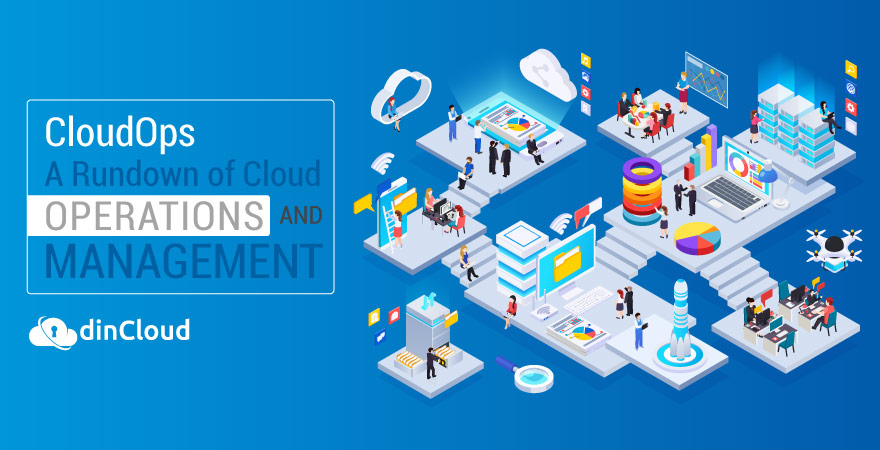Enterprises are rapidly pivoting towards public Cloud Service Providers (CSP) like dinCloud. While the flexibility and scalability that is characteristic of the public cloud is good, it still needs a decent amount of management to achieve cost and performance optimization.
In the absence of efficient and well orchestrated Cloud Operations (CloudOps), enterprises would be falling behind the value generation curve, which was the whole point behind making a move to the public cloud infrastructure.
Rather, confining CloudOps to just the public cloud might also not be entirely true. The need for effective and efficient cloud operations is equally important for enterprises that decide to deploy a private cloud environment, for better control or compliance.

Related: 6 Reasons that make Cloud Computing a True Lifesaver
The Guiding Principles of CloudOps
Cloud operations mostly rely on the principles of continuous integration and deployment (CI/CD). The main yardstick for the success of CloudOps is the level of availability of the cloud infrastructure, and how optimized are the business processes over the Cloud.
Now that we have an overview of cloud operations, let us take a look at the responsibilities these CloudOps teams have to shoulder.
Managing Configuration
This starts with allocating workloads that will run on-premise, and the ones which will be outsourced to the public Cloud Service Provider. This scope can also extend to more than one cloud provider, in the case of multi cloud environments.
Allocating Resources
Unlike on-premise resources, you are billed for the resources that you consume over the cloud. So, cloud operations teams have to keep tabs on the usage levels of cloud resources, so they still retain their expected value proposition.
Optimizing Performance
The prime responsibility of cloud operations teams is to ensure a seamless end user experience, by minimizing latency and maximizing the performance of applications. The same also applies to the processes that are hosted over the cloud infrastructure.
Related: Virtual Desktop Market to show Strong Growth till 2022 and Beyond
Compliance Posture
When allocating workloads between on premise resources and the cloud, as well as among the various cloud providers, cloud operations teams have to be mindful of meeting all the applicable requirements pertaining to compliance and regulation.
Enforcing SLAs
Any enterprise that goes for the cloud mostly has an elaborate Service Level Agreement (SLA). It is imperative for CloudOps teams to monitor those SLAs, to ensure that each party to the agreement is lifting its side of the burden which these operations pose.
Why are Cloud Operations Vital?
Some may question the need for having CloudOps, especially when a public Cloud Service Provider (CSP) has been engaged. Well, things don’t work that way. Granted the CSP will be responsible for maintaining the cloud infrastructure, but there is more to it.
In order to extract that last ounce of performance from your cloud environment, and ensure that the cloud service is delivering the value it was intended for, close management and monitoring of the deployment is required. Hence, the need for CloudOps experts.
Related: How Cloud Computing Aligns with Strategic Business Goals?
How Automation Streamlines Cloud Operations?
Like countless other areas of technology, automating cloud operations delivers a lot of value and optimization to the deploying enterprises. The traditional approach towards provisioning of Virtual Machines, or other cloud resources is user based and obsolete.
An automation driven approach to the area of provisioning ensures that cloud native applications and processes can automatically ramp up resources as and when there is a surge in demand. The same resources can be de-provisioned later.
By automating the provisioning and de-provisioning of cloud resources, deploying enterprises can achieve both process as well as cost optimization. Once automated, all that is required is to change the underlying rules, if, as, and when that is required.
The role of automation within cloud operations does not stop at just provisioning, rather it can extend to areas such as the management of cloud users, security and even Application Programming Interfaces (APIs).
Related: Outlook for Infrastructure & Operations (I&O) in 2021
Conclusion
Having a well planned and executed mechanism for cloud operations results in a better end user experience, resource as well as cost optimization. Technologies like Artificial Intelligence (AI) and Machine Learning (ML) are making CloudOps a lot simpler.
Contact dinCloud for fully managed cloud services that are secure, reliable and very cost efficient due to a Flat Rate Pricing Model.


